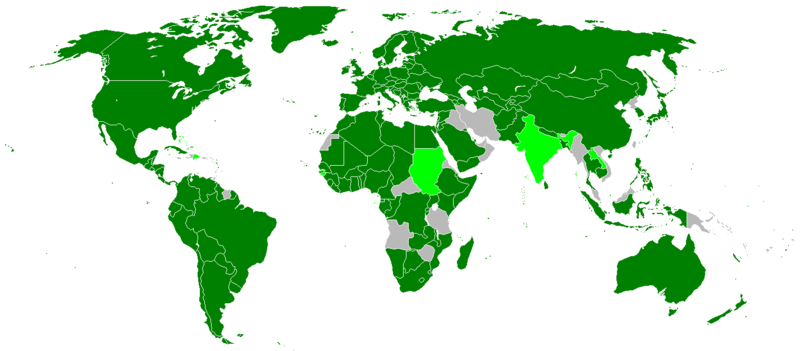Good day. Are you in search of some uplifting news? If so, this is the wrong stop. Last Wednesday, June 26th, was International Day in Support of Victims of Torture, and you may not be aware that the Convention against Torture is both the most widely adopted international human rights treaty and the most widely violated. Here is a map of countries that have ratified (dark green), or at least signed (light green), that treaty.

As you can see, almost all countries have done so. Now take a look at a map depicting Amnesty International’s 2005 allegations of the propensity of each country’s government to violate the CAT, with dark red being “systematic” violators and white being “infrequently.” Green represents countries where AI did not level any allegations of CAT violations during 2005. If you click the map you can watch a video that depicts how AI’s allegations of CAT violations have changed over 1995-2005. Review of AI’s reports suggest that the situation has improved little over the past five years.
[vimeo http://www.vimeo.com/35348578 w=500&h=281]Government torture or ill-treatment, 1995 to 2005 from Andreas Beger on Vimeo.
That map does not distinguish among types of violations: ill treatment, versus torture techniques that leave no trace (from water boarding and stress positions through electro-shock), and techniques that leave evidence on the body (beating, cutting, whipping, etc.). In his 2007 book, Democracy and Torture, Darius Rejali documents that “stealth torture” (techniques that leave no trace) was developed in the US, UK, and France between 1920 and mid-century as courts began to reject confessions that had been coerced, and police needed to be able to “pressure suspects” without leaving telltale marks of that abuse. Courtenay Conrad and I have a working paper, “Political Institutions, Plausible Deniability, and the Use of Stealth Torture” (PDF), that explores differences in government’s use of these different techniques. We argue that because minorities who have little electoral impact (criminals, dissidents and members of marginalized groups) are the people who governments torture, the majoritarian institution of free and fair elections will not constrain governments from using scarring techniques, but that politically independent courts, which are antimajoritarian, will. Consistent with our hypotheses we use the ITT data and find that free and fair elections are associated with both a greater incidence of scarring torture and a lower incidence of stealth torture (governments need not hide from majorities) and that independent courts are associated with a lower incidence of scarring torture and a greater incidence of stealth torture (governments do need to hide from independent judges).
Well, I wonder what your reaction is. We have presented this working paper at a conference at Rice University, the International Studies Association, the Columbia University Workshop on Human Rights, and at the Peace Research Institute, Oslo. This stands out to Conrad and I: people have negative emotional responses to torture and positive emotional responses to elections, and thus do not like our findings. At Columbia the discussion became sufficiently heated that the Chair of the Workshop gently, but firmly, admonished the participants, and then gave an impressive impromptu defense of the scientific method as a tool for studying human rights.
I confess, I expected elections to have no impact: the positive impact on scarring torture (controlling for a whole host of other factors) surprised me, and I have not yet fully accepted it. Courtenay and I have tried to “make it go away”: we anticipated almost every control variable that anyone has suggested at these four presentations, and in the near future will explore the few we have yet to include. We are also less than satisfied with our statistical model, though a more sophisticated model should only let us parse more detail about the substantive effects of variables rather than the sign of their impact.
And last week I found further evidence consistent with what we are finding. At the Rice conference Sarah Croco suggested to Conrad and I that we ought to be able to design what is called a survey experiment to probe the underlying argument. In a survey experiment you create two different versions of your question and randomly assign half of the respondents to hear each version of the question. Last fall Croco, Conrad and I were able to insert a small battery of questions into the Cooperative Congressional Election Study during the November 2012 US elections. The three of us are apparently pretty busy because we have had the data since April, and I did not eyeball them until spurred last week by International Day in Support of Victims of Torture to do so. Croco, Conrad and I have considerable work to do before we have any findings to present in a paper, but I will share this.
Twenty three percent of the Americans surveyed believe that at least one of the following agencies ought to have the authority to whip a detainee during interrogation. That’s right, whip them. Whipping is a canonical scarring torture technique.
Judges, Police Officers, Soldiers, Immigration Officials
You might be thinking: well, you have soldiers in that list. Eleven percent of the respondents (half of the 23 percent) said at least two of those agencies should be able to whip, three percent of whom believed all four should.
That is our control group. The other half of the people we surveyed were given a list with a fifth government agency (geek alert: this is known as a list experiment): intelligence. How do the numbers change when we add intelligence agency to the list? Among that group of Americans 29 percent said at least one agency should be able to whip detainees during an interrogation, and 4 percent said all five should be able to do so.
We also asked a handful of other questions and will be able to probe the impact of the following upon American’s attitudes toward the government’s use of torture: the gender and nationality of the suspect, the government’s allegation (traffic stop versus “ticking time bomb”), the political party affiliation, income, race, and age of the respondent, and so forth.
Perhaps some of you are cynical about Americans, and wish to turn the American Exceptionalism claims trumpeted by shills like Sam Huntington (and scores of politicians) on its head. Before you get too excited about the prospect of “blood thirsty Americans” versus the “civilized people of ___________,” recall the finding that led Croco to propose the survey experiments: holding other variables constant, governments that hold free and fair elections engage in a higher incidence of scarring torture and lower incidence of stealth torture. It is not just Americans who fail to use the polls to press their government to hide its abuse.
I close as I opened. Good day.
@WilHMoo






9 comments
So, this is saying that no allegations have been made against India and Kazakhstan??? Chad and Ethiopia???
Max, it does look like that, but it turns out that we were a bit sloppy making the map. The explanation gets a tad complex, but here goes. One value coders can assign is -99, and we plotted those as green, so some of the green countries are no allegations but others (e.g., India) are -99, which is assigned when there was an Allegation, but AI failed to specify whether the abuse was Infrequent, Systematic, or somewhere in between. Apologies for the goof up.
Second, the variable we plot on that map codes only allegations made by AI about conditions throughout a country for the year (what we call Country Year allegations). ITT also codes more narrowly focused allegations (what we call Specific Allegations), but those are not plotted in this map. So it is possible that AI will have made no CY allegations against a country, but have made SA allegations.
CRC is the most widely ratified international human rights treaty, not CAT. Otherwise, interesting post.
Thanks for the correction, Joel.
Interesting stuff, and consistent with an argument Wendy Wong and I make in a recent paper, where we find that democracies are less likely to change repressive behavior in light of naming and shaming by Amnesty International. HR abuses are good electoral politics in some places and at some times.
Some joker named Idean was talking up that BJPS article of yours today.
This post h as piqued my interest in mine with regards to what surveys and experiments tell us about broad aggregate findings from cross-national research (follows from my twitter reactions, and some thoughts I’ve been having on similar issues in IPE). So herewith:
I have a very tough time figuring out what this list experiment can show with regard to your cross-national findings. The problem is that you have cross-national findings about aggregate patterns, yet you are using a list experiment which is designed to elicit sensitive beliefs in one country. Those projects just seem orthogonal to me.
It’s also worth noting that as far as I can tell, your experimental findings are very small. 29% (treatment) – 23% (control) = 6%. That’s not a large effect at all. I wonder how many people think that Martians should be able to whip people. Or, to be less silly, what some placebo results would have shown.
But the larger issue I have is this. Let’s say you had found no effect in your list experiment. Or a gigantic effect. The estimand here, remember, is just an estimate of the prevalence of a belief in a population. Neither would have any bearing on your aggregate findings about elections and the use of scarring torture.
The survey experiment sounds really interesting. I guess I’m not as surprised as you are that about 25 percent of Americans would support whipping. You might remember the public opinion paper that Rejali and Gronke had in the PS symposium on torture and terrorism a couple of years ago (one version is here: http://www.cforjustice.org/wp-content/uploads/2010/01/TortureWhitePaperV2.pdf). Appendix 2 has details on support for specific techniques. Quite a few are in the range that you found; support for “punching/kicking” (which might be the technique on their list closest to whipping) is 18 percent in one poll and 29 percent in another. So you data seems to be in line with this, which is good from a scientific perspective, and seems consistent with your argument about majoritarianism, but bad from the perspective of how we would hope people would think.